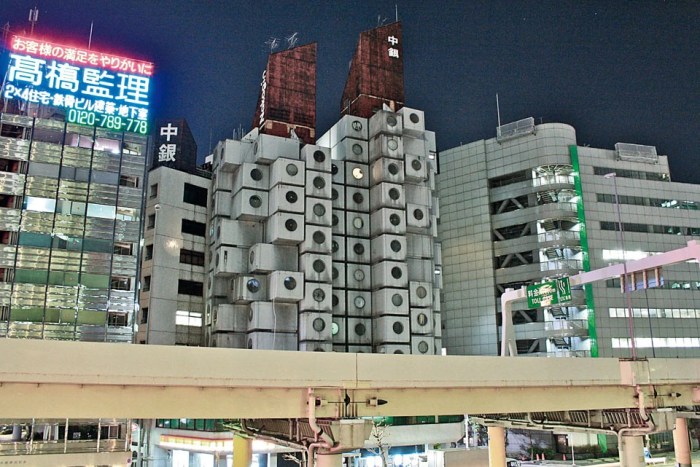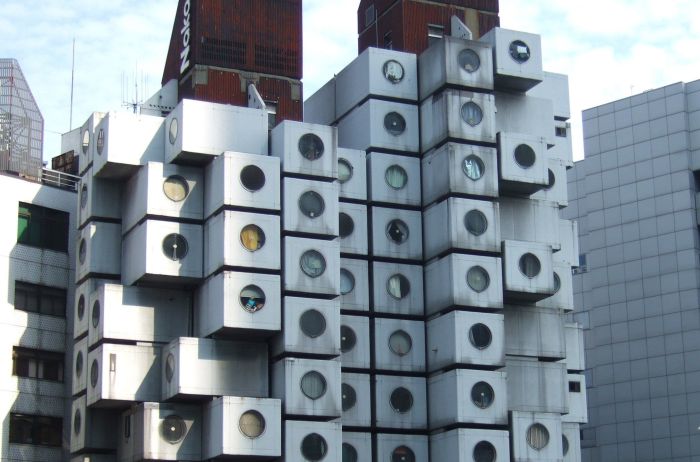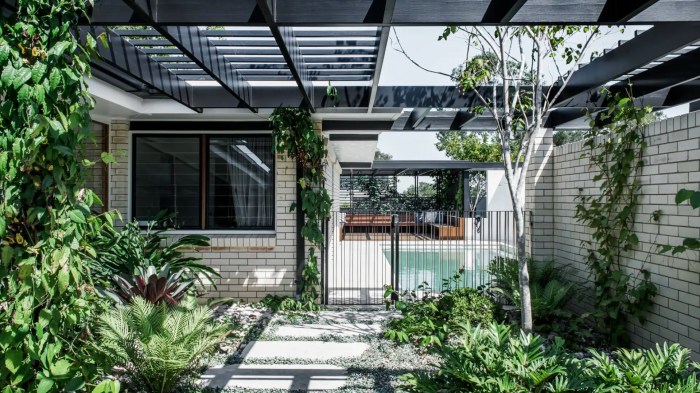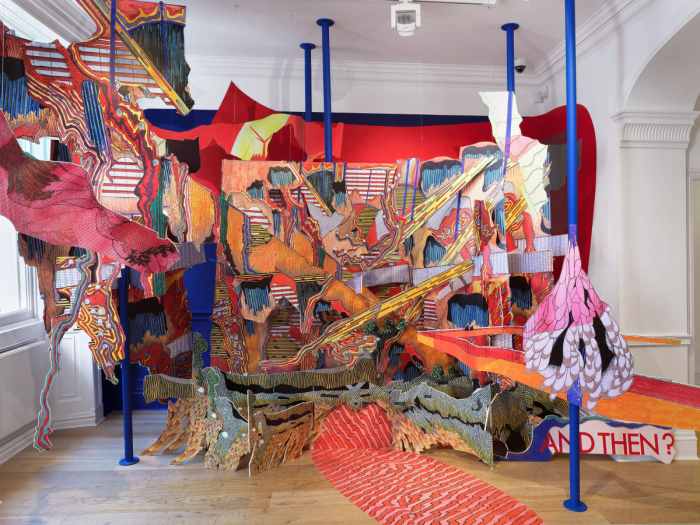Metabolist Movement A Vision for the Future
The Metabolist Movement, a pivotal moment in architectural and urban design history, offered a radical vision for the future. Emerging from the post-war reconstruction era, this influential group of architects and urban planners envisioned a symbiotic relationship between humans and the built environment, prioritizing organic forms and sustainable practices.
This movement’s core principles revolved around the concept of “urban metabolism,” envisioning cities as dynamic systems constantly exchanging resources and energy. Key figures like Kenzo Tange played crucial roles in developing this groundbreaking philosophy, shaping its aesthetic and theoretical framework. The movement’s influence extends to contemporary design challenges, inspiring innovative solutions to modern urban problems.
Defining the Metabolist Movement

Source: domusweb.it
The Metabolist Movement, a significant architectural and design philosophy, emerged in post-war Japan, profoundly influenced by the devastation of World War II and the burgeoning optimism of a new era. This movement envisioned a dynamic, evolving relationship between humans and their built environment, pushing boundaries and exploring radical concepts of urban planning and design.
The movement’s unique approach stemmed from a desire to create a more adaptable and resilient urban landscape, responding to the needs of a rapidly changing society. This was fueled by the realization that traditional approaches to architecture and urban design were insufficient to address the challenges of a modern, industrialized world. The movement’s core philosophy, deeply rooted in biology and the concept of metabolism, sought to create structures that could evolve and adapt alongside the needs of society.
Historical Context and Influences
The devastation of World War II profoundly impacted Japan, triggering a need for rapid reconstruction and a desire for a new, more innovative approach to design. This context, coupled with the rise of technological advancements and the burgeoning Japanese economy, created a fertile ground for the emergence of the Metabolist Movement. Influences from Western modernism, particularly the work of Le Corbusier and other prominent architects, were also apparent. Furthermore, the Japanese emphasis on nature and organic forms, as seen in traditional Japanese architecture, also contributed to the movement’s distinctive characteristics.
Core Philosophical Underpinnings
The Metabolist Movement’s core philosophy was deeply rooted in the biological concept of metabolism, emphasizing the dynamic interplay between organisms and their environments. This perspective extended to architecture, viewing buildings not as static objects but as living entities capable of adapting and transforming over time. The movement championed the idea of designing cities and structures that could grow, change, and respond to the evolving needs of society. This approach to design fundamentally differed from traditional architectural practices, which often prioritized static and unchanging forms.
Defining Principles of the Metabolist Movement
The Metabolist Movement’s core tenets are Artikeld in the following table:
| Principle | Description | Example |
|---|---|---|
| Organic Growth and Adaptation | Structures should be designed to evolve and adapt to changing needs and circumstances. Flexibility and adaptability were paramount. | A building that can be modified and expanded as societal needs change, rather than being fixed in its initial form. |
| Integration with Nature | Buildings should be integrated with their natural surroundings, emphasizing natural light and ventilation. Organic shapes and natural materials were common design elements. | Buildings with large, expansive windows that maximize natural light and integrate with the surrounding greenery. |
| Technological Innovation | Embracing new technologies to enhance the functionality and adaptability of structures. The movement envisioned structures that could be altered, extended, and even transformed. | Utilizing innovative materials and construction techniques, such as prefabricated components or advanced structural systems, to create more adaptable buildings. |
| Urban Metabolism | Understanding the city as a living organism, where structures and systems interact dynamically to sustain the city’s functions. | Urban designs that prioritize efficient transportation systems, resource management, and sustainable infrastructure to foster a dynamic urban environment. |
| Dynamic Spaces | The movement emphasized the importance of fluid and changing interior spaces, allowing for adaptation and reconfiguration as needs evolved. | Interior spaces are designed with movable partitions, flexible layouts, and adaptable furniture to accommodate varying uses. |
Key Figures and Influences
The Metabolist Movement, with its innovative approach to architecture and urban planning, drew inspiration from a diverse range of sources. This section delves into the key figures who shaped the movement’s unique aesthetic and theoretical framework, examining their contributions and the architectural and design influences that profoundly impacted their work. Furthermore, a comparison with concurrent movements highlights both similarities and distinctions.
The Metabolist architects, designers, and theorists weren’t isolated figures; their work was deeply intertwined with the socio-political and technological landscape of post-war Japan. This interaction influenced their ideas, leading to a unique blend of innovation and societal concern. They envisioned a future shaped by dynamic, organic structures, adapting to the ever-changing needs of a rapidly evolving society.
Key Figures and Their Contributions
The Metabolist Movement encompassed a network of individuals who contributed to its core ideas and designs. Their combined efforts fostered a cohesive and impactful vision.
- Kenzo Tange, a prominent figure in Japanese architecture, catalyzed the movement. His role was crucial in establishing a platform for collaboration and the exploration of radical new approaches to urban design and construction. He actively championed the development of dynamic, organic structures, emphasizing adaptability and flexibility in response to evolving societal needs. Tange’s influential position within the architectural community provided a strong foundation for the movement’s expansion and recognition.
- Kisho Kurokawa, another significant contributor, played a pivotal role in developing the theoretical underpinnings of the Metabolist Movement. His concept of “metabolism” underscored the organic growth and change inherent in urban development. Kurokawa’s theoretical framework focused on the dynamic relationship between buildings and their environment, emphasizing the adaptability and transformability of structures to accommodate shifting needs. He championed the idea of structures as living entities, capable of evolving and changing along with society.
- Fumihiko Maki, an important figure, contributed significantly to the visual aesthetic of the movement. Maki’s designs reflected a commitment to modern materials and innovative construction techniques, translating the movement’s theoretical principles into tangible architectural expressions. His designs highlighted the interplay between structure and environment, creating a harmonious relationship between buildings and their surroundings.
Architectural and Design Influences
The Metabolist Movement drew inspiration from various architectural and design influences, creating a unique and innovative blend.
- Organicism: The concept of organic architecture, exemplified by the work of Frank Lloyd Wright, profoundly impacted the Metabolist approach. The emphasis on flowing forms and adaptable spaces resonated with the Metabolist’s desire for structures that responded dynamically to their environment.
- Modernism: The modernist movement’s emphasis on functionality and clean lines influenced the Metabolist’s focus on efficient and adaptable structures. However, the Metabolists diverged by prioritizing dynamism and evolution.
- Japanese Aesthetics: Traditional Japanese architectural principles, such as the integration of nature and the concept of spatial fluidity, also played a role. This is evident in the Metabolist’s sensitivity to the environment and their use of open spaces and flexible layouts.
Comparison with Other Movements, Metabolist Movement
The Metabolist Movement shared some common ground with other movements of the era, yet it possessed unique characteristics.
- Modernism: Both movements prioritized functionality and innovation, but Metabolists went further by emphasizing dynamism and adaptability. Modernism focused more on static forms, whereas the Metabolists sought structures that could evolve with time.
- Brutalism: While both explored innovative construction techniques, Brutalist architecture often embraced raw, exposed concrete, contrasting with the Metabolists’ aim for seamless integration with the surrounding environment and emphasis on aesthetic harmony.
Key Figures and Contributions Table
| Key Figure | Significant Contribution |
|---|---|
| Kenzo Tange | Championed dynamic, adaptable urban design; established a platform for collaboration. |
| Kisho Kurokawa | Developed the theoretical foundation of “metabolism,” emphasizing organic growth and change. |
| Fumihiko Maki | Transformed the theoretical principles into tangible architectural expressions, highlighting the interplay between structure and environment. |
Architectural and Urban Design Concepts
The Metabolist movement envisioned a dynamic and responsive relationship between architecture and the urban environment, profoundly impacting future city planning. Their unique perspective stemmed from a deep concern for the rapid pace of urbanization and the need to create sustainable and adaptable urban spaces. This approach emphasized the constant evolution of cities, recognizing their organic and living nature.
The Metabolists viewed cities not as static structures but as complex organisms undergoing constant change. Their designs aimed to capture this dynamism through flexible, adaptable structures that could evolve alongside societal needs and environmental conditions. This organic approach distinguished their work from traditional, static urban planning models.
Metabolist Vision of the Future City
The Metabolist vision for the future city prioritized the concept of urban metabolism, acknowledging the intricate interplay of human activities and the surrounding environment. Their designs sought to seamlessly integrate buildings and infrastructure into the urban fabric, fostering a symbiotic relationship between human life and the urban ecosystem. This holistic approach aimed to create vibrant and adaptable urban landscapes that could respond to the changing needs of the inhabitants. They envisioned cities as dynamic entities, constantly evolving and adapting.
Innovative Architectural Structures
Metabolist architecture embraced innovative structural systems, emphasizing flexibility and adaptability. These structures were often conceived as interconnected networks, allowing for future expansion and modification. The movement’s emphasis on organic forms and responsive designs reflected their belief in the importance of adapting architecture to the environment and societal needs. Their structures aimed to interact with natural forces, such as wind and light, harmoniously. This approach distinguished them from the prevailing architectural styles of the time, which often prioritized static and monumental forms.
Urban Metabolism and the Built Environment
The Metabolist concept of urban metabolism emphasizes the cyclical exchange of resources and energy within the urban environment. Their designs aimed to minimize waste and maximize the efficient use of resources, reflecting a deep understanding of the interconnectedness of urban systems. This philosophy aimed to create self-sufficient and sustainable urban environments. They sought to reduce the environmental impact of urban development by creating structures that could adapt to changing conditions and demands.
Metabolist Urban Design Concepts
This section details various Metabolist urban design concepts and their corresponding characteristics, illustrating their vision for dynamic and adaptable urban spaces.
| Concept | Description |
|---|---|
| Vertical City | This concept proposed high-density, multi-layered urban structures, optimizing space utilization and fostering a sense of community. These structures often integrated vertical gardens and open spaces to connect residents with nature. |
| Mobile Architecture | This approach emphasized adaptable structures capable of shifting or expanding to meet changing needs. These structures might have been designed to respond to shifts in population density or economic activity. |
| Organic Urban Forms | This design philosophy emphasized fluid and dynamic urban structures that responded to natural elements. They aimed to create a harmonious relationship between the city and its surroundings. |
| Interconnected Networks | This approach involved integrating buildings and infrastructure into interconnected networks, promoting efficient resource flow and communication. The buildings were not isolated but connected through pathways and networks. |
Design Principles and Aesthetics: Metabolist Movement

Source: isu.pub
The Metabolist movement’s core design principles revolved around a dynamic and adaptable approach to architecture and urban planning, reflecting its organic view of the built environment. These principles, intertwined with a unique aesthetic sensibility, sought to create structures responsive to the needs of a rapidly evolving society.
The Metabolists envisioned cities as living organisms, constantly changing and adapting to the demands of their inhabitants. This organic perspective fundamentally shaped their design philosophy, emphasizing flexibility, modularity, and a deep connection to the surrounding environment. Their aesthetic choices mirrored this, favoring materials and forms that echoed natural processes.
Design Principles
The Metabolist design principles emphasized the fluidity and changeability of the built environment. Flexibility, a cornerstone of their approach, allowed structures to adapt to evolving needs and societal changes. Modularity, another key principle, enabled the creation of adaptable components that could be easily rearranged or replaced. Organic forms, drawing inspiration from natural processes, further underscored this philosophy.
- Flexibility: Structures were designed to change and adapt to future needs, reflecting the idea that cities and buildings should be dynamic entities. This often involved modular components that could be rearranged or removed as circumstances evolved. The concept of a “flexible city” emphasizes its ability to evolve with its inhabitants. For instance, a housing unit could be expanded or reconfigured depending on the needs of the family over time.
- Modularity: Components could be easily combined and rearranged, allowing for greater adaptability and potential for modification. Think of it like Lego blocks, where different elements could be fitted together to create diverse structures, ensuring efficiency and adaptability.
- Organic Forms: The aesthetic drew inspiration from the natural world, emphasizing curved shapes and flowing lines. Structures resembled living organisms, embodying the idea of constant change and adaptation.
Aesthetic Qualities
Metabolist aesthetics were characterized by a unique approach to materials, forms, and color palettes. Their designs often incorporated innovative materials, reflecting a forward-looking approach to construction. The aesthetic sought to achieve harmony with the environment and convey a sense of dynamism.
- Materials: Metabolists experimented with innovative materials, often seeking to blend the natural and the artificial. Concrete, steel, and glass were frequently used, but with a focus on their potential for flexibility and adaptability, often employing prefabricated elements to speed up construction and enhance adaptability. This showcased a forward-looking approach to construction techniques, anticipating future possibilities.
- Forms: Curved shapes, flowing lines, and asymmetrical designs were favored. This aesthetic departure from traditional rectilinear forms aimed to capture the dynamism and complexity of natural systems, reflecting the idea of continuous change and development.
- Color Palettes: Aesthetics leaned toward neutral and earthy tones, often integrating natural elements such as wood and stone. This aesthetic choice aimed to create a sense of harmony and integration with the surroundings. The color palette frequently featured subtle variations, reflecting the ever-changing nature of the environment.
Contemporary Applications
Metabolist principles are surprisingly relevant to contemporary design challenges. The concepts of flexibility and modularity are highly applicable to modern construction methods, offering solutions to issues like sustainability, cost-effectiveness, and adaptability.
- Sustainable Design: The emphasis on adaptability and modularity in Metabolist designs aligns well with contemporary concerns about sustainable development. Modular construction reduces waste and allows for easier dismantling and reuse of components. This approach also enhances the lifespan of buildings, making them more sustainable in the long term.
- Adaptable Spaces: The focus on flexible and adaptable spaces is extremely useful for addressing the dynamic needs of modern society. These adaptable spaces can be reconfigured and repurposed to meet changing requirements. This allows for greater flexibility in terms of usage and design.
- Prefabrication: The concept of prefabrication and modular construction, central to Metabolist ideas, is increasingly prevalent in contemporary construction practices. Prefabricated elements allow for quicker construction, reduced on-site labor, and better quality control. This can significantly impact the speed and cost-effectiveness of projects.
Comparison with Other Modern Styles
| Characteristic | Metabolist | International Style | Brutalism |
|---|---|---|---|
| Form | Organic, flowing, adaptable | Geometric, rectilinear, symmetrical | Raw, monumental, concrete |
| Materials | Innovative, often combining natural and artificial | Modern, industrialized materials (steel, glass, concrete) | Concrete, steel, often exposed |
| Flexibility | High, emphasizes adaptability | Moderate forms are generally fixed | Low, often large, fixed forms |
| Aesthetics | Dynamic, responsive to environment | Clean, functional, universal | Raw, powerful, monumental |
Impact and Legacy
The Metabolist Movement, while originating in a specific historical context, continues to exert a profound influence on contemporary architectural and urban design. Its innovative ideas and visionary approach to urban planning remain highly relevant, particularly in the face of burgeoning global challenges such as population growth, climate change, and resource scarcity. The movement’s emphasis on dynamic, responsive, and ecologically conscious design offers a valuable framework for addressing these issues.
The enduring appeal of Metabolist principles stems from their proactive and forward-thinking nature. Concepts like organic growth, adaptability, and the integration of technology into the built environment continue to resonate with architects and urban planners seeking sustainable and resilient solutions for future cities.
Impact on Subsequent Trends
The Metabolist Movement significantly impacted subsequent architectural and urban design trends by introducing novel concepts of urban metabolism and the interconnectedness of buildings with their surroundings. Their emphasis on dynamic structures, adaptable spaces, and symbiotic relationships between nature and the built environment inspired a shift toward more organic and responsive designs. This can be seen in the growing interest in biomimicry and sustainable design principles that emerged in later decades. Furthermore, the Metabolist focus on technology’s role in shaping the built environment laid the groundwork for contemporary explorations of digital design and construction techniques.
Resonance with Contemporary Issues
The Metabolist approach continues to resonate deeply with contemporary issues in urban planning and sustainable development. The movement’s emphasis on integrating nature into urban spaces, fostering community engagement, and embracing technological innovation directly addresses the needs of modern cities grappling with issues like climate change, resource depletion, and social inequality. For example, the principles of urban metabolism, which highlight the flow of resources and energy within a city, directly inform contemporary discussions on sustainable resource management and circular economy models.
Enduring Influence of Principles and Ideas
The core principles of the Metabolist Movement—the concept of continuous urban transformation, dynamic and adaptable structures, and the symbiotic relationship between humans and nature—continue to shape architectural and urban design discourse. Their pioneering exploration of urban metabolism, the concept of a city as a complex system, remains a crucial element in the development of sustainable urban strategies. These principles have influenced subsequent generations of architects, urban planners, and designers, who are now seeking to integrate these concepts into their work.
Examples of Contemporary Projects Inspired by Metabolist Concepts
| Project Name | Key Metabolist Concepts Reflected | Description |
|---|---|---|
| The “Vertical Farm” in the Netherlands | Urban Metabolism, Symbiosis with Nature, Integration of Technology | This innovative agricultural project demonstrates the Metabolist principle of integrating agriculture into urban landscapes. Vertical farming structures optimize space utilization and minimize environmental impact. The project leverages technology to enhance crop yields and reduce waste. |
| The “Modular Housing” Development in Japan | Adaptability, Dynamic Structures, Technological Integration | These innovative housing units demonstrate the Metabolist approach to adaptable and dynamic spaces. The modular design enables the units to be reconfigured and repurposed over time, promoting flexibility and sustainability. This design philosophy allows for adaptability to evolving needs. |
| The “Living Bridges” in various cities globally | Symbiosis with Nature, Urban Connectivity, Integration of Public Spaces | These innovative bridges, integrating green spaces and public areas, highlight the Metabolist concept of connecting urban environments with nature. They serve as public spaces, creating opportunities for community interaction and engagement. |
Visual Representations
The Metabolist Movement, with its emphasis on organic growth and dynamic urban spaces, relied heavily on visual representations to communicate its complex ideas. Architectural drawings and models played a crucial role in conveying the movement’s vision of a symbiotic relationship between humans and the environment. These visual aids allowed for the exploration of abstract concepts and offered tangible representations of the movement’s core principles.
Visual representations of Metabolist ideas were not limited to static drawings; they also encompassed diagrams, illustrations, and photographs. These diverse forms of visual communication facilitated a deeper understanding of the movement’s principles and aspirations, allowing the public and fellow architects to engage with the intricate details of the proposed designs.
Key Architectural Drawings and Models
Metabolist architects frequently employed detailed drawings and models to showcase their innovative concepts. These representations often emphasized the dynamic and evolving nature of their proposed structures, contrasting sharply with the static, fixed designs prevalent at the time. Models, particularly, were crucial in conveying the spatial relationships and potential for transformation within the built environment.
- Kenzo Tange’s “Metabolism” model: This model, often considered a cornerstone of Metabolist visualization, portrayed a city in constant flux, with buildings adapting to changing needs and environments. The model’s dynamic nature exemplified the movement’s belief in a symbiotic relationship between architecture and the urban fabric. The visual language, employing organic forms and shifting spatial configurations, highlighted the importance of adaptation and growth in urban planning. The model’s symbolic meaning underscored the movement’s optimistic vision for the future of cities.
- Architects’ Workshop’s diagrams and sketches: These often employed a blend of abstract and realistic representations to convey the concept of modularity and adaptability in architectural design. They visually showcased the idea of “metabolizing” buildings—their ability to change and evolve according to the needs of the inhabitants and the environment. These visual representations often featured diagrams illustrating the interconnectedness of different building elements and how they could be reconfigured. The symbolic meaning of these drawings and sketches underscored the importance of flexible design and the dynamic nature of urban spaces.
Visual Representations of Metabolist Ideas
Metabolist architects used a variety of visual tools to communicate their ideas. Diagrams were often employed to illustrate the interconnectedness of urban elements, showcasing the flow of people, goods, and energy within the city. Illustrations were used to portray the proposed structures in various stages of development and evolution, emphasizing the adaptability and flexibility inherent in Metabolist design.
- Diagrams of Urban Systems: These diagrams, often highly detailed, depicted the intricate flow of transportation, communication, and other urban systems. The diagrams effectively showcased the interconnectedness of various elements and highlighted the movement’s vision of a highly integrated urban environment. The use of these visual tools underscored the importance of systems thinking and the interplay between the built environment and the surrounding urban fabric.
- Illustrations of Modular Structures: Illustrations often depicted the modular components of Metabolist buildings, emphasizing the ease of assembly, disassembly, and modification. These illustrations highlighted the movement’s emphasis on flexibility and the ability of structures to adapt to changing needs. The symbolic meaning of these illustrations underscored the movement’s forward-looking approach to architecture.
Visual Representations in Communication
The movement’s visuals were crucial in effectively communicating its core concepts. The use of dynamic models and detailed diagrams allowed for a deeper understanding of complex ideas, conveying the essence of Metabolist thought clearly and concisely. The representations fostered engagement with the movement’s principles and aspirations.
| Visual Representation | Description |
|---|---|
| Kenzo Tange’s “Metabolism” model | A dynamic model illustrating a city in constant flux, with buildings adapting to changing needs and environments. Highlights the symbiotic relationship between architecture and the urban fabric. |
| Architects’ Workshop’s diagrams and sketches | A blend of abstract and realistic representations showcasing modularity and adaptability in architectural design. Emphasizes the “metabolizing” ability of buildings. |
| Diagrams of Urban Systems | Detailed diagrams depicting the flow of transportation, communication, and other urban systems, highlighting interconnectedness and systems thinking. |
| Illustrations of Modular Structures | Illustrations showcasing the modular components of Metabolist buildings, emphasizing flexibility and adaptability. |
Critical Analysis and Evaluation
The Metabolist Movement, while visionary and influential, faced challenges in its practical application and reception. This section examines the strengths and weaknesses of the movement, its utopian aspirations, and the context surrounding its critical reception. Understanding these aspects provides a nuanced perspective on the lasting impact of this pioneering architectural and urban design philosophy.
Strengths of the Metabolist Movement
The Metabolists presented a compelling vision for a dynamic, evolving urban environment. Their emphasis on organic growth, adaptability, and technological integration offered a powerful response to the perceived limitations of existing urban structures. Their embrace of innovative materials and construction methods showcased a proactive approach to tackling future challenges, such as population growth and resource scarcity.
| Pro | Con |
|---|---|
| Emphasis on Adaptability and Growth: The Metabolists championed designs that could respond to changing needs and evolve. This adaptability is crucial in a rapidly changing world, and the concept of dynamic urban environments is increasingly relevant. | Difficulties in Practical Implementation: The complex and often ambitious designs presented significant challenges in terms of cost, construction, and maintenance. Their ideas, though innovative, often proved difficult to translate into tangible, real-world projects. |
| Technological Innovation: The movement’s embrace of advanced materials and construction techniques foreshadowed future trends in sustainable and high-tech architecture. | Limited Realization: The movement had limited success in translating its theoretical concepts into completed buildings. Lack of funding, changing priorities, and societal contexts often hampered its progress. |
| Emphasis on Community and Interaction: The focus on creating spaces that foster social interaction and community engagement remains highly relevant. Their ideas about public spaces and communal living areas address fundamental aspects of urban planning. | Utopian Idealism: The movement’s emphasis on an optimistic and idealized future may have alienated some critics who questioned the feasibility of such grand visions. |
Weaknesses of the Metabolist Movement
Despite its innovative ideas, the Metabolist Movement also faced criticism and practical challenges. Their approach to urban design, while ambitious, was sometimes perceived as overly abstract and impractical.
Utopian Ideals and Limitations
The Metabolist Movement’s utopian aspirations, while inspiring, also had limitations. The belief in a future where technology and design could solve all urban problems risked neglecting the social and political realities that shape urban environments. The movement’s vision of a technologically advanced and harmonious future was not universally shared or attainable. Examples of other utopian movements, such as the futuristic cities proposed in the early 20th century, often encountered limitations due to unforeseen factors and societal complexities.
Context of Reception and Critique
The Metabolist Movement’s reception was mixed. While some architects and urban planners were impressed by its innovative ideas, others viewed the designs as impractical or aesthetically unappealing. The movement’s focus on the future and the challenges of a rapidly changing world may have seemed radical or unrealistic to some critics. The historical context of post-war Japan and the global political climate of the time also shaped the reception and critique of the Metabolist Movement.
Last Recap

Source: failedarchitecture.com
In conclusion, the Metabolist Movement stands as a testament to the power of design to address complex societal issues. Its vision of a dynamic, interconnected urban environment, characterized by flexible structures and sustainable practices, continues to resonate with contemporary urban planning and sustainable development initiatives. While its utopian ideals faced challenges, the Metabolist Movement left an enduring legacy, inspiring future generations of architects and urban planners to strive for a more harmonious relationship between humanity and the built environment.





